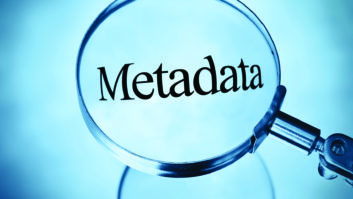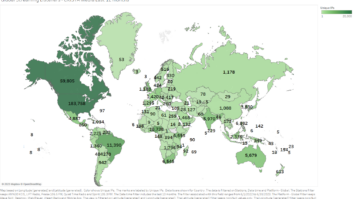
All images courtesy of RAI/Radio DNS
LONDON:Where would modern radio stations be without the Internet?
As “online” increasingly becomes part of everyday life, this is becoming a key question for many broadcasters, aspiring to utilize this relatively new platform to their best advantage.
Today even the smallest radio stations have developed their own Web presence. Some have even managed successfully to monetize the “long tail” of additional listening and interaction that results. However, despite investment in websites and online audio content, a fundamental problem remains: how to link the online world with real-time broadcasting, which for the vast majority of listeners remains their core platform and one that has thus far tended to remain stubbornly offline.
Largely disconnected from the Internet in all its various forms, traditional radio has difficulty in taking advantage of the various interactivity and other benefits the online world can offer — and which audiences increasingly have come to expect.

RadioDNS is targeting these issues. And while still in an introductory phase, the technology has advanced to a point where services and trials are being run in various countries, and receivers are starting to emerge.
The beginning
In a concerted attempt to solve this problem, back in 2008 Global Radio and the BBC began to study ways of bringing together these two separate worlds more effectively. The shared objective was to develop ways of delivering additional information to receivers so that individual listeners could select and follow up on their own particular interests.
Using the limited data capacity of broadcast platforms alone was not enough and any such approach would be unable to solve the problem of the missing return path, meaning that listeners would still not be able to interact with the station being listened to.
The obvious solution to both the capacity and the return path dilemmas was to use the Internet to build some sort of direct link between primary broadcast material and additional, optional materials made available online.
According to Nick Piggott, Global Radio’s head of creative technology, the key issue was how to add visual content to radio, not to make radio a primary medium demanding positive visual interaction, but instead offering “ambience and a visual compliment to radio’s existing core audio content.”
In short, broadcast radio stations want to be able to provide the same breadth of background “sensory experience” that services such as Pandora, Last.FM and various online radio stations provide, but to the mass, locally focused, audiences, which only broadcast platforms currently can deliver. Of course, as well as enhancing the listener experience, this complimentary channel also offers the potential for developing additional commercial opportunities, such as music downloads and paid product links.
Sensory experience
Due to the need to ensure that any initial linkages between broadcasting and Internet-delivered content would be implemented without any necessity for listener involvement in the set-up process, any system developed must be simple to operate and easy to automate.

However, against the need for simplicity, there is also the issue of security to consider, protecting broadcaster reputations by ensuring that any links created are positively identified to avoid misdirection to incorrect Internet addresses. The solution, according to Piggott, was to make use of various unique identifiers that already exist in broadcasting and convert these into a unique code that would identify the station involved with no risk of incorrect routing.
FM and digital radio stations have recognized frequencies as well as Program Identification (PI) and Service Identifier Data (SID) codes. Considering that when taken together these codes are unique, a positive station identification can be made. In practice, however, when users first investigated this approach they encountered instances where, by chance, two FM stations operating on the same frequency happened to have the same RDS PI code.
As a result, the U.K.’s broadcast radio regulator, Ofcom, has put in place mechanisms to ensure that such duplicates are removed and to prevent them from recurring. Having confirmed that, with care, unique station identifiers can be produced reliably, the next question becomes how to make these Internet-friendly.
According to Piggott, the principle behind collaboration with other broadcasters was to “agree on the technology, but then to compete on content.” This approach has been adopted successfully in relation to other U.K. radio broadcasting projects such as the recent launch of the U.K. Radioplayer.In this case, collaboration with the BBC led to a “eureka moment” when one of the corporation’s employees observed: “This looks a bit like DNS.”
The approach was then clear: If the unique identifier for a given radio station can look like an Internet domain address, Domain Name System servers can easily convert it to a standard IP address. This method also made things easier for the project, because on that basis the only requirement was to make sure that the identifier could be delivered to the DNS servers, and from then on all communication would be directly between the radio station concerned and the receiver involved.

Moving forward
Continuing on the principle of collaboration, RadioDNS was formed as a membership association, which now includes members representing both public and commercial radio stations from around the world. By April 2010, this association was ready to release an open-source specification, which has now been finalized ready for standardization. Services are now operating on various radio stations in Europe, Australia and North America; and there has been considerable interest in the system from a variety of broadcasters in various countries.
As with any new radio broadcasting innovation, in practical terms, the impact of RadioDNS will largely be dictated not only by the actions of broadcasters themselves, but, critically, the approach taken by receiver manufacturers.
“Receiver manufacturers say that RadioDNS is attractive and easy to implement, because it simply uses existing technology in a new way and, crucially, it does so without involving additional license fees,” said Piggott.
With the principles of RadioDNS agreed and established, over recent months considerable effort has been invested in developing practical implementations. At this year’s EBU Digital Radio Conference, options for “added value” services using RadioDNS in the form of content enhancement, personalization and transaction integration were discussed.
Practical approaches to Web-friendly delivery of ancillary visuals and click-through e-commerce and feedback were demonstrated alongside searchable Radio EPG and personalized content “tagging,” which allows listeners to bookmark items of interest heard and then explore them further later, for example via a laptop or other Web-enabled device.
As RadioDNS enables a variety of new functionality to be delivered alongside broadcast radio, broadcasters are pursuing a range of hybrid initiatives within the project. Public and private broadcasters in Germany are providing visualization, and exploring how devices can switch automatically between DAB and IP streaming. U.S. broadcasters are looking at tagging and switching between FM, HD and IP.
Australian broadcasters are providing visuals. In the U.K., the BBC has trials of visualization and recently undertook listener trials of tagging in collaboration with Global and Frontier Silicon.Italian broadcaster RAI is investigating providing 3D visualization for radio. Overall, trials and services are happening in most European countries, North America, Canada and in Australia.
At present, the only readily available DAB/FM radios available featuring color displays suitable for displaying Web content are the Pure Sensia and Revo Axis. However, DAB designers at Frontier Silicon, suppliers of the majority of DAB/FM radio chipsets, have now integrated RadioDNS capabilities into the company’s designs. This means that other receiver manufacturers can now begin to develop their own next generation screen-based broadcast and IP hybrid receivers.
Throughout 2012, the RadioDNS consortium plans to focus on further raising the profile of the project within the broadcast industry and to continue developing the standard and various applications using it.
At present, although some RadioDNS services are operational, public awareness of what this means for radio going forward is, understandably, minimal as the consortium wants robust, standardized, implementations in place before publicly promoting the standard’s capabilities by moving out of the current “soft launch” phase.
The fact that the consortium plans to make logos and trademarks available to receiver manufacturers this year suggests that a fully publicized “hard launch” is not that far off.
Lawrie Hallett reports on the industry for Radio World from Norwich, England.












